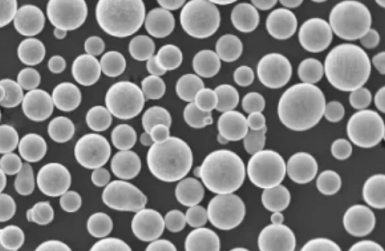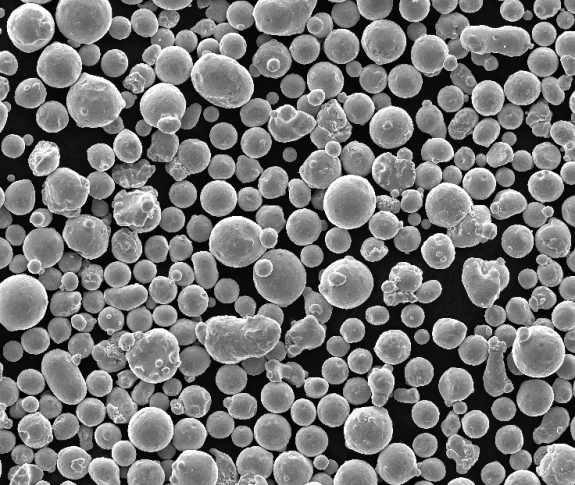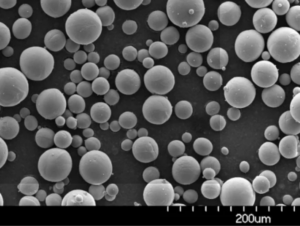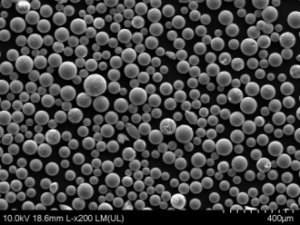概要 積層造形パウダー
アディティブ・マニュファクチャリング(積層造形)は、3Dプリンティングとしても知られ、粉末状のさまざまな材料を利用して、部品や製品を層ごとに構築する。選択される粉末の種類は、使用される特定の積層造形プロセスと、完成部品の望ましい特性によって異なります。
積層造形用粉末の主な種類には、以下のようなものがある:
- 金属粉末 粉末溶融炉や指向性エネルギー蒸着プロセスで使用される。一般的な材料は、チタン、アルミニウム、スチール、ニッケル合金、コバルトクロムなど。
- ポリマー粉末 – 粉末床溶融および材料噴射プロセスで使用される。一般的な材料には、ナイロン、ABS、ポリカーボネート、ポリスチレン、熱可塑性ポリウレタンなどがあります。
- セラミックパウダー – バインダージェットと材料押出工程で使用される。一般的な材料は、シリカ、アルミナ、ジルコニア、ポーセレンなど。
- 砂と鋳物粉 – 金属鋳物の鋳型や中子を作るバインダージェッティング工程で使用される。通常はシリカベース。
- 生体適合性及び生体活性粉末 医療用途に使用される。一般的な材料には、チタン、ハイドロキシアパタイト、リン酸三カルシウムなどがある。
積層造形用パウダーの特性は、プリント部品の特性、品質、精度、性能に大きく影響します。主な粉末特性は以下の通りです:
積層造形用粉末組成物
アディティブ・マニュファクチャリングは、金属、ポリマー、セラミック、砂、その他の粉末材料を利用し、さまざまな印刷プロセスに合わせた特定の組成を持つ。
金属粉末
| タイプ | 一般的な作曲 |
|---|---|
| チタン合金 | Ti-6Al-4V、Ti-6Al-7Nb、Ti-Al-Fe、Ti-Al-Mn、Ti-Al-Sn |
| アルミニウム合金 | AlSi10Mg, AlSi12, スカルマロイ |
| 合金鋼 | 17-4PH、316L、304L、4140 |
| ニッケル合金 | インコネル 625, 718; ハステロイ X |
| コバルト・クロム | CoCrMo |
ポリマー粉末
| タイプ | 一般的な作曲 |
|---|---|
| ナイロン | ナイロン11、ナイロン12 |
| ABS | アクリロニトリル・ブタジエン・スチレン |
| ポリカーボネート | ビスフェノールA型ポリカーボネート |
| ポリスチレン | PS、ハイインパクトPS |
| 熱可塑性ポリウレタン | TPU |
セラミックパウダー
| タイプ | 一般的な作曲 |
|---|---|
| シリカ | フューズド・クォーツ、クリストバライト |
| アルミナ | Al2O3 |
| ジルコニア | ZrO2、YSZ(イットリア安定化) |
| 磁器 | ガラス、粘土、長石の混合物 |
砂と鋳物粉
| タイプ | 作曲 |
|---|---|
| 珪砂 | ほとんどがSiO2で、金属酸化物や非金属酸化物がわずかに含まれる。 |
| ジルコンサンド | ケイ酸ジルコニウム |
| オリビンサンド | ケイ酸鉄マグネシウム |
| クロマイトサンド | クロム酸化鉄 |
生物活性および生体適合性粉末
| タイプ | 一般的な作曲 |
|---|---|
| チタンと合金 | 純チタン、Ti-6Al-4V |
| ハイドロキシアパタイト | Ca10(PO4)6(OH)2 |
| リン酸三カルシウム | Ca3(PO4)2 |

積層造形パウダー プロパティ
部品の品質とプロセスの性能に影響を与える積層造形用粉末の主な特性には、以下のようなものがある:
| プロパティ | 説明 | 意義 |
|---|---|---|
| 粒度分布 | 粉体粒子寸法の範囲と分布 | 粉体の流動性、充填密度、層の均一性、解像度に影響する。 |
| 形態と形状 | 粉体粒子のアスペクト比と形状因子 | 散布、充填密度、パウダーフローに影響 |
| 密度 | バルクパウダーの質量/体積比 | 部品の重量と寸法精度を決定します。 |
| 流動性 | 応力下で粉体が自由に流動する能力 | パウダー層の均一な散布と再コーティングに不可欠 |
| 含水率 | 粉末中の水分含有率 | 高水分はパウダーの凝集と印刷不良を引き起こす |
| 化学組成 | 元素組成と存在する相 | 機械的特性、微細構造、完成部品の性能を定義する。 |
積層造形用パウダーの用途
積層造形用パウダーは、主要産業の機能部品の印刷に使用されている:
| 産業 | 用途 | 使用材料 |
|---|---|---|
| 航空宇宙 | タービンブレード、航空機部品、ロケットエンジン | チタン合金、ニッケル合金、アルミニウム合金、コバルトクロム |
| 自動車 | プロトタイピング、ギア、ブラケットなどの部品製造 | アルミニウム合金、ナイロン、ABS |
| メディカル | 歯科用コーピング、インプラント、外科用器具 | チタン合金、コバルトクロム、ステンレス鋼 |
| 消費者 | 宝飾品、装飾品、照明器具 | 金、銀などの貴金属、ポリマー |
積層造形用パウダーの仕様
特定の積層造形プロセスで使用される粉末材料は、特定のサイズ、組成、特性のしきい値に適合する:
| プロセス | 粒子サイズ | 合金グレード | 規格 |
|---|---|---|---|
| パウダーベッド融合 | 15-45ミクロン | ASTM F3001によるTi-6Al-4V ELI | アストマ F3049、アストマ F2924、アストマ F2971 |
| バインダー噴射 | 20~60ミクロン | 420または316ステンレス鋼 | ASTM F3301、MPIF 35 |
| 材料噴射 | 5~25ミクロン | 60-65ショアDポリウレタン | – |
| 直接エネルギー蒸着 | 45~150ミクロン | インコネル718、316Lステンレス鋼 | アストレムF3055、アストレムF3302 |
積層造形用粉末サプライヤー
金属、ポリマー、セラミック、複合材料の添加製造用粉末を幅広く提供するサプライヤーの強固なネットワークがある:
| 会社概要 | 粉体材料 | コスト範囲 |
|---|---|---|
| LPWテクノロジー | チタン合金、アルミニウム合金、ステンレス鋼、ニッケル合金 | kgあたり100~500ドル |
| サンドビック・オスプレイ | ステンレス合金、ニッケル合金、コバルト合金 | kgあたり50~250ドル |
| 先端パウダー&コーティング | ナイロン系ポリマー、PEEK、PEKK | kgあたり80~600ドル |
| エクスワン・カンパニー | ステンレス鋼, 工具鋼, タングステンカーバイド, インコネル625 | kgあたり75~1000ドル |
| ヘガネス | ステンレス鋼、鉄基合金 | kgあたり30~150ドル |
| ケナメタル | タングステンカーバイトコバルト、17-4PHステンレス | kgあたり100~1200ドル |
| 3Dセラム | アルミナセラミック、ジルコニアセラミック、シリカ | kgあたり100~250ドル |
における比較 積層造形用粉末
製造工程、コスト、部品特性、品質に関して、様々な粉末オプションの間にはかなりの違いがある:
| パラメータ | ポリマーパウダー | 金属粉 | セラミックパウダー |
|---|---|---|---|
| ビルドレート | ミディアム | 遅い | 速い |
| 決議 | ミディアム | 高い | 中~低 |
| 部品強度 | 低~中 | 非常に高い | 中~高 |
| 部品精度 | ミディアム | 中~高 | 低~中 |
| 表面仕上げ | ミディアム | 高い | 低~中 |
| 熱特性 | 低融点、低導電性 | 高融点、高導電性 | 高融点、低伝導性 |
| 部品単価 | 低~中 | 高い | ミディアム |
| 後処理 | 最小限 | 広範囲 | ミディアム |
粉末床積層造形を使用する利点
粉末床技術を部品製造に使用する主な利点には、以下のようなものがある:
- 鋳造や機械加工では不可能な、複雑で軽量な形状を作る能力
- 未使用のパウダーはリサイクルされるため、原材料の無駄が少ない
- 専用工具や金型を必要としないため、迅速な試作が可能
- 鍛造材に匹敵する高い強度、耐久性、耐熱性、耐食性を示す部品
- 気孔率と微細構造を容易に制御できる
- 複数の材料や合金、グレードの高い組成でも印刷可能。
- リードタイムを最小限に抑えたジャスト・イン・タイム生産が可能

粉末床積層造形の限界
粉末床積層造形には、考慮すべき欠点がいくつかある:
- 他のプロセスに比べ、設備コストや運用コストが高い
- 熱間静水圧プレスのような追加の後処理は、しばしば不可欠である。
- 粉体の取り扱い手順と設備には特別な注意が必要
- ある種の柔軟なポリマーやゴムのような素材の印刷には課題がある
- 大量生産や大量生産のシナリオには向いていない
- ビルドチャンバー寸法によるサイズ制約のため、大型部品の再設計が必要になる場合がある。
よくある質問
Q: アディティブ・マニュファクチャリングに最もよく使われる金属粉末は何ですか?
A: Ti-6Al-4Vのようなチタン合金は、その高い強度重量比と生体適合性から、最も人気のある金属粉末の一つです。アルミニウム合金、ステンレス鋼、コバルトクロム、ニッケル超合金も非常によく使われています。
Q:AMプロセスで使用される粉末はどのくらい細かいのですか?
A: 一般的なサイズ範囲は10-100ミクロンですが、プロセスによっては1-10ミクロンの超微粒子ナノパウダーを使用することもできます。20ミクロン以下の微細なパウダーは、より優れた解像度と精度をもたらします。
Q: アディティブ・マニュファクチャリング用パウダーの価格には何が影響しますか?
A: 原料コスト、組成、合金の種類、粒度分布、流動性、形態などの粒子特性、純度レベル、購入量が価格を決定します。複雑な合金は単純な合金よりもコストが高くなります。
Q:積層造形において、粉末粒子の形状は重要ですか?
A: はい、流動性、充填密度、展延性に優れた球状パウダーは、印刷中に非常に不規則なパウダーや角ばったパウダーに比べ、はるかに優れた性能を発揮します。粒子形状は密度、層の均一性、表面仕上げに影響します。
Q: 市販の粉末でもAMプロセスに使用できますか?
A: そうとは限りません。ほとんどのプロセスでは、理想的な流動性と融合を確保するために、3Dプリンティング用途に特化した組成、サイズ、形状のカスタムパウダーが必要です。厳格な品質管理を行う定評のあるメーカーのみをお勧めします。
Q: アディティブ・マニュファクチャリングにおいて、未使用の金属粉末はどのように再利用またはリサイクルされるのですか?
A: プリント後、未焼結パウダーはフィルターで大きな凝集物を除去し、少量の新鮮なパウダーとブレンドすることで、流動性、密度、組成を厳しい範囲内に維持します。このパウダーリサイクルにより、コストと廃棄物が大幅に削減されます。
Q: 粉末床式3Dプリントで層間剥離が発生する原因は何ですか?
A: 層間の結合が不十分なのは、予熱が不適切であったり、粉末の分布が不均一であったり、エネルギー投入が不十分であったり、熱勾配が不利であったり、粒子の充填密度が低かったりすることが一般的な原因です。プロセスパラメーターの最適化が重要です。
Q:積層造形用金属粉末は可燃性の危険物ですか?
反応性元素粉末や合金粉末の多くは、細かく分割すると非常に可燃性が高くなる。適切な換気、機器の電気的接地、特殊な排気システム、火花探知機、消火設備が不可欠な安全対策である。粉体の保管や取り扱いにも特別な注意が必要です。
Additional FAQs on Additive Manufacturing Powder
1) How do I select powder particle size for different AM processes?
- LPBF: typically D10–D90 ≈ 15–45 μm.
- Binder jetting: 5–25 μm (fine) or 20–60 μm depending on sintering route.
- DED: 45–150 μm for stable feeding. Match PSD to machine recoater and energy source.
2) What powder attributes most influence density and mechanical properties?
- Sphericity and narrow PSD (improves flow/packing), low interstitials (O/N/H), low moisture, minimal satellites/voids, and chemistry within ASTM/ISO spec. These reduce porosity and variability.
3) How much used powder can be blended back without risking quality?
- Common practice is 20–50% recycled blend-back with sieving and QC per lot; monitor O/N/H, PSD, flow, and build coupons. Retire powder when trends exceed control limits.
4) Which standards apply to AM-grade metal powders and their qualification?
- ISO/ASTM 52907 (feedstock requirements), ASTM F3055 (Ni alloys), F3001/F2924 (Ti), F3184 (CoCr), F3302 (DED process control), plus NFPA 484 for combustible metal safety.
5) What are typical causes of powder bed defects (e.g., streaks, lack of fusion)?
- Poor flow due to humidity or satellites, wide PSD tails, high oxygen, incorrect recoater settings, suboptimal energy density, and contamination. Address via powder conditioning, classification, environment control, and parameter optimization.
2025 Industry Trends in Additive Manufacturing Powder
- Green/blue laser LPBF expands pure copper and high‑Si aluminum applications; tighter O2 specs in chambers and powders.
- Binder jetting matures for steels and copper with standardized sinter/HIP playbooks, enabling large parts at lower cost.
- Sustainability and traceability: material passports linking powder genealogy, reuse cycles, and in‑situ build data; EPDs required by aerospace/medical OEMs.
- Hybrid powder routes: gas atomized base powders reconditioned by plasma spheroidization to cut satellite content for premium builds.
- Regionalization: new atomization capacity in North America/EU for supply resilience and export‑controlled alloys.
| 2025 Metric (AM Powder) | Typical Range/Value | Why it matters | ソース |
|---|---|---|---|
| LPBF PSD target (metals) | D10–D90 ≈ 15–45 μm | Recoating stability, density | ISO/ASTM 52907 |
| Ti‑6Al‑4V ELI oxygen (powder) | ≤0.13 wt% O | Implant ductility/fatigue | ASTM F136/F3001 |
| Copper LPBF conductivity | 80–95% IACS with green lasers | Thermal/electrical performance | Peer‑reviewed AM studies; OEM notes |
| Binder‑jetted 17‑4PH density after sinter/HIP | 97–99% | Production‑grade properties | Vendor case studies |
| Typical reuse blend‑back in serial LPBF | 20–50% recycled | Cost control, sustainability | Industry benchmarks |
| Indicative AM powder price bands | ~$20–$500/kg (alloy/process dependent) | Budgeting and sourcing | Supplier quotes/trackers |
Authoritative references and further reading:
- ISO/ASTM 52907 and related AM standards: https://www.astm.org and https://www.iso.org
- NFPA 484 (combustible metals safety): https://www.nfpa.org
- NIST AM Bench datasets: https://www.nist.gov
- ASM Handbook, Powder Metallurgy and Additive Manufacturing: https://www.asminternational.org
Latest Research Cases
Case Study 1: Plasma Spheroidization Upgrade for GA IN718 Powder (2025)
Background: An aerospace supplier saw recoater streaks and elevated porosity from satellite‑rich gas‑atomized Inconel 718 lots.
Solution: Applied plasma spheroidization as a secondary step with inert gas recirculation; tightened classification and humidity control; implemented powder passports tracking O/N/H and PSD per lot.
Results: Satellite count reduced from ~10–12% to <3%; Hall flow improved by 15–20%; LPBF porosity dropped from 0.40% to 0.10% without changing build parameters; tensile scatter narrowed by 30%.
Case Study 2: Binder‑Jetted Stainless Tooling with Closed‑Loop Powder Reuse (2024)
Background: A tooling shop required large conformal‑cooled inserts at lower cost and lead time.
Solution: Used fine 17‑4PH binder‑jet powder, validated sinter + HIP cycle, and instituted 30–40% powder blend‑back with lot‑wise QC.
Results: Final density 97–98.5%; cycle time reduced 35%; per‑insert cost down 18%; powder waste reduced 45% via sieving and moisture control.
Expert Opinions
- Prof. John Hart, Professor of Mechanical Engineering, MIT
Key viewpoint: “Powder passports that tie PSD and interstitials to in‑situ monitoring are foundational for statistically defensible, production‑scale AM.” - Dr. Laura Schmidt, Head of Additive Manufacturing, Fraunhofer IAPT
Key viewpoint: “Green and blue lasers are converting copper and aluminum powders from difficult to dependable materials in LPBF.” - Dr. Brent Stucker, AM standards contributor and industry executive
Key viewpoint: “Binder jetting, paired with mature sinter/HIP recipes, is now a reliable path to large, cost‑sensitive metal parts.”
Citations for expert profiles:
- MIT: https://meche.mit.edu
- Fraunhofer IAPT: https://www.iapt.fraunhofer.de
- ASTM AM CoE: https://amcoe.org
Practical Tools and Resources
- Standards and safety
- ISO/ASTM 52907; ASTM F2924/F3001/F3055/F3184; ASTM F3302 (DED); NFPA 484
- Powder characterization and QC
- LECO O/N/H analyzers: https://www.leco.com
- PSD (ASTM B822), apparent/tap density (ASTM B212/B329), Hall/Carney flow, SEM morphology
- Design and simulation
- Ansys Additive, Simufact Additive, Autodesk Netfabb; nTopology for lattices/conformal cooling
- Market and data
- Senvol Database (machines/materials): https://senvol.com/database
- NIST AM Bench datasets: https://www.nist.gov
Last updated: 2025-08-21
Changelog: Added 5 targeted FAQs, a 2025 trends table with metrics and sources, two recent AM powder case studies, expert viewpoints with citations, and practical tools/resources.
Next review date & triggers: 2026-02-01 or earlier if ISO/ASTM feedstock standards change, OEMs publish new copper/aluminum LPBF datasets, or AM powder pricing/availability shifts >10% QoQ.

